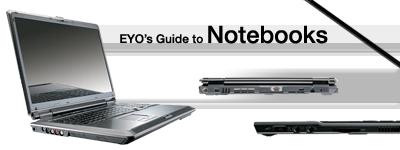Guide to Mobile Computer and Notebook Technology!
(The copyrights© of all EYO Feature Articles are the property of Eyo Technologies Pty Ltd. Reproducing without permission is prohibited.)

EYO's Guide to Mobile Computer and Notebook Technology!
For highly mobile users, a good notebook is an essential productivity tool. Today’s notebooks adhere to pretty much every communication and connectivity standard – Wifi, Bluetooth, IR, USB and Firewire – and most of them also incorporate card readers and PCMCIA expansion slots. So you should never need to make a choice between two notebooks because one has Bluetooth and the other doesn’t.
Where notebooks tend to differ is in their underlying hardware – generally the CPU and chipset. Intel have a wide range of notebook CPU technologies, all designed to offer a balance between maximising performance and maximising battery life. The older standard are the Pentium M processors. These are a few years old now, and while they’re neither as powerful nor efficient as the newer CPUs, they still do a good job. One distinct benefit of a Pentium M-based system is that they are very competitively priced. You can pick up an excellent unit like the Acer TM 2418WLCi for as much as a full desktop system.
The newer range of mobile CPUs are the Intel Core Solo, Core Duo and Core 2 Duo processors. Core Solo and Duo processors use essentially the same technology, but the Core Duos have two active processing cores, sharing 2MB of L2 cache. The Core 2 Duo CPUs are the newest generation of mobile processors, and they do offer an excellent combination of power and battery life. Apart from the principle technical advantages of the processor, it’s also supported by the latest chipset technology, all of which is as efficient as you can get. Notebooks based on a Core 2 Duo CPU like the ASUS F3JP-A9002C are certainly more expensive that Pentium M-based units, but you get all the benefits of reduced heat and prolonged life and mobility. If the notebook is important to you, then these are features worth paying for.
Aside from the CPUs, notebooks can differ radically from each other depending on what peripherals they have been manufactured with. For example, the graphics cards on integrated notebook motherboards have traditionally been quite underpowered, and unsuitable for 3D graphics work. The latest Intel GMA950 embedded graphics adaptor is capable of 3D rendering, but not at a particularly high level. So some notebooks like the Fujitsu Lifebook E8210H come with a dedicated 3D graphics adaptor and graphics RAM. These systems are capable of very good 3D rendering for graphics-intensive applications and even gaming.
Memory and storage are also highly variable between systems. Most notebooks come with at least 512MB RAM, while the newer models have around 1GB. But depending on the system you can expand this anywhere up to 4GB. Recent advances in hard drive technology also mean that 2.5” notebook drives are becoming quite large. Most notebooks have around 40-80GB drives, but some like the Acer TM 4235WLMi-Pro have a whopping 160GB – more than enough for anyone’s mobile storage needs.
Remember when looking at buying a notebook that you’re in fact purchasing a complete system, so the software bundle is just as important as the hardware. You don’t want to buy the unit only to discover that you need to buy more software to fulfill some basic productivity or entertainment requirements. Also, the warranty on a notebook is very important – much more important than on a desktop. Desktop systems are quite easy and relatively inexpensive to fix when things go wrong, but notebooks are a different story. Replacement parts are expensive and labour costs even more so – and trying a DIY repair on a notebook isn’t recommended.
Notebooks have come a long way and today’s unit are worthy desktop replacements, packed with power and possibilities!
EYO feature article write ups: Tell us a topic your interested in and we'll write about it!
EYO Technologies is asking you our valued customers to submit a technology or product related topic you would like us to write about and publish in our website. If you'd like to see a particular topic feature on any trends, technological advancement in computers or just want to learn more about a product then do let us know! Our friendly staff will look into your suggestion and if we think it would be useful we will write about it to be published on our homepage.
Simply email your suggested topic to:
Check out the past articles we have explored for our customers:

 Kingston Tool
Kingston Tool

